|
Kinon SL-III |
Manufactured or assembled in Taïwan from (Circa) 1980 to (Before) 1985.
Index of rarity in France: Rare (among non-specialized garage sales)
Inventory number: 3134
See the complete technical specifications
Chronology of cameras Kinon
The cameras manufactured by Formosa Plastics Corporation are recognizable by the adhesive label marked "FPC Quality Passed." The problem is that this label easily peels off. The markings on the lens cannot help with identification because the same ones are found on cameras manufactured by Ouyama, suggesting that the lens is a common subcontract among several manufacturers in Taiwan. These markings are fanciful, using a fictitious serial number. They sometimes suggest functions that do not exist. For example, "Auto Fix focus" simply means there is no focus adjustment; it is a fixed focus. The word "Auto" is there to deceive.
One can attempt to determine main types among this production. It is noticed that the differences between two types are sometimes minimal. Dating is very difficult, although there is an evolution in shapes to follow the design of major brands.
To add to the confusion, the cameras bear various commercial trademarks, which are mostly hollow shells. The same model name can be used for different devices (e.g., Licom MXF-700). Some models bear well-known brands because they have been used for advertising purposes (e.g., Time). Other names, such as Nikanon, are only there for their resemblance to major brands like Nikon and Canon.
| Markings on lens | # on lens | |||
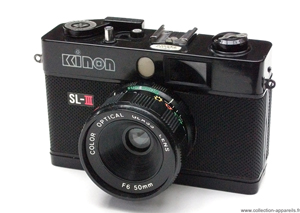 Like a Haking camera Like a Haking cameraOval window above the lens, serving no purpose |
Kinon SL-III |
 |
Color Optical Glass Lens F 6 50 mm |
|
 Opaque window in line with the lens (non-functional) Film advance lever |
Super II |  |
Optical Color Lens Auto Fix Focus 50 mm Lens 1:6 |
|
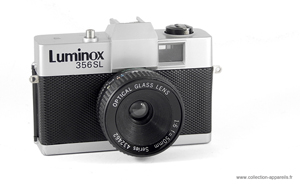 Off-center viewfinder Off-center viewfinderProminence of the bulge towards the front |
Luminox 356 SL |
Optical Glass Lens 1:6 f=50mm series 432462 |
432462 | |
| Premier PC-90 |
Optical Glass Lens series 198523 |
198523 | ||
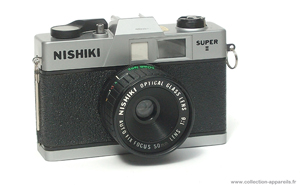 Off-center viewfinder Off-center viewfinderOpaque window in line with the lens (non-functional) Film advance lever |
Nishiki Super II |
Nishiki Optical Glass Lens Auto Fix Focus 50mm Lens 1:6 |
||
 Off-center viewfinder Off-center viewfinderOpaque window in line with the lens (non-functional) Frame counter on the top cover |
Optiflex NF-1 |
Optiflex Color Optical Glass Lens 1:6 f=50mm series 746277 |
746277 | |
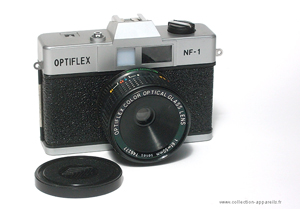 Off-center viewfinder Off-center viewfinderOpaque window aligned with the lens (non-functional) |
Optiflex NF-1 |
Optiflex Color Optical Glass Lens 1:6 f=50mm series 746277 |
746277 | |
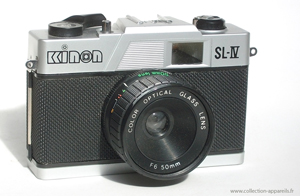 Film advance lever Film advance leverWide and low shoe base |
Kinon SL-IV |
Color Optical Glass Lens F 6 50 mm |
||
 Off-center viewfinder. Off-center viewfinder.Covered window under the bulge. The shutter release button is on a small platform. |
BW-7000 | Optical Color Lens Auto Fix Focus 50mm Lens 1:6 |
||
| UCC UC300 | ||||
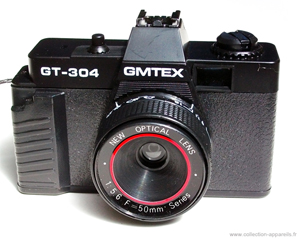 SLR-like form. Side viewfinder. Bulge for better grip. |
GMTEX GT-304 |  |
New Optical Lens 1:5.6 f 50 mm Series |
|
| Comax LT-002 |  |
Comax Optical Lens 1:6 f 50 mm Series |
||
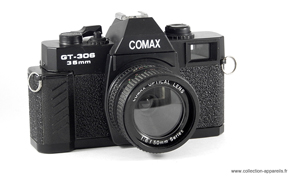 SLR-like shape. Side viewfinder. Bulge for better grip. Advance lever. |
Comax GT-306 | Comax Optical Lens 1:6 f 50 mm Series |
||
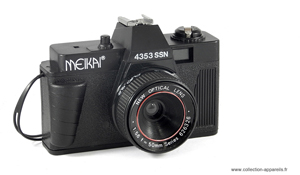 SLR-like shape. Side-mounted viewfinder. Bulge for improved grip. |
Meikai 4353 SSN | New Optical Lens 1:5,6 f=50 mm Series 626326 |
626326 | |
| ESC | ||||
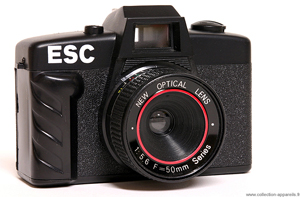 SLR-like shape. Viewfinder aligned with the lens. |
ESC | New Optical Lens 1:5,6 F = 50 mm Series |
||
| Roniflex X3000 | ||||
| GM Tex GT-304 | ||||
 Off-center viewfinder. Window obscured beneath the bulge. |
(Time) | Kinetic Optical Color Lens Auto Fix Focus 50mm Lens 1:6 |
||
| Nikanon RX-7 |
Nikanon Color Optical Glass Lens 1:6 f=50mm series 746277 |
746277 | ||
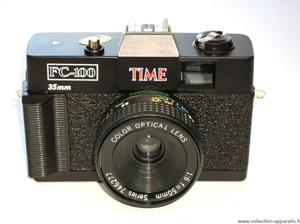 |
FC-100 (Time) |  |
Color Optical Lens 1:6 f=50mm series 746277 |
746277 |
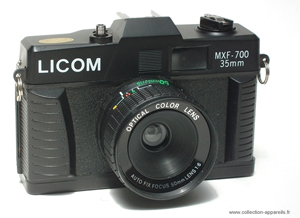 Finger rest at each end. Finger rest at each end.Off-center viewfinder. Window obscured beneath the bulge. |
Licom MXF-700 |
 |
Optical Glass Lens Auto Fix Focus 50mm Lens 1:6 |
|
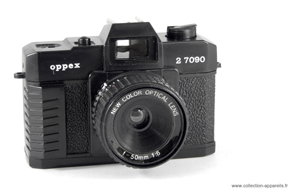 Reflex-like appearance. Viewfinder within the faux prism bulge. |
Oppex 2 7090 | New Color Optical Lens f=50mm 1:6 |
||
| Oppex 7090 | ||||
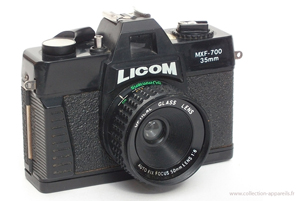 Reflex-like appearance. Reflex-like appearance.Viewfinder within the faux prism bulge. Advance lever. |
Licom MXF-700 |
Optical Glass Lens Auto Fix Focus 50mm Lens 1:6 |
||
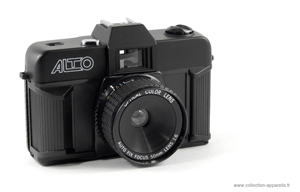 Reflex-like appearance. Reflex-like appearance.Viewfinder within the faux prism bulge. |
Alto | Optical Color Lens Auto Fix Focus 50mm Lens 1:6 |
||
| Deluxe-III | ||||
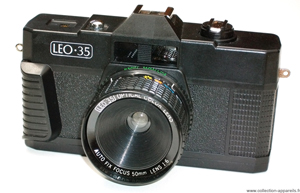 SLR-like shape. Two viewfinder windows aligned with the lens. |
Leo.35 | Leo. 35 Optical Color Lens Auto Fix Focus 50 mm Lens 1:6 |
||
 Reflex-like appearance. Reflex-like appearance.Finger rest at one end. Off-center viewfinder. Window obscured beneath the bulge. |
Eureka 2436 | New Color Optical Lens 1:6 f=50mm series 347859 |
347859 | |
| Weyburn F6 | ||||
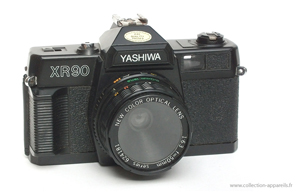 Reflex-like appearance. Reflex-like appearance.Off-center viewfinder. Finger rest on the right-hand side. |
Yashiwa XR90 |
New Color Optical Lens 1:6,3 f=50mm series 624181 |
624181 | |
__________
We know this was made by the Formosa Plastics Corporation because all known examples have a sticker on them reading "FPC Quality Passed".
It has not yet been possible to determine an accurate date for this camera, but the high shutter release (threaded for cable release or a timer) and lever wind suggest a date in the late 1970's or early 1980's. The Formosa Plastics Corporation had been looking for new ways to use its resin since the mid 1950's, and Kodak had made plastic cameras for many years, but the major manufacturers did not embrace plastics for 35mm cameras until the mid 1970's.
Cameras of this type were made to be very inexpensive because they were often given away at corporate promotions and as fair ground prizes. In the right hands they seem to be capable of images similar to those of an Instamatic, but they are no good for fast film or close up photography. They are also prone to light leaks in direct sunlight, which some people seem to find appealing.
The lens has focal length of about 42mm (not 50mm), the apertures are formed by a moving slot of varying width and are reasonably accurate on this model. Cameras of this type often had metal added to give a little extra weight.
FPC made a number of 'Kinons' most of which have clones under other names. This one is probably the first of them, and appears to be unique. The other reasons for buying it were the interesting graphics, and the cheeky rearrangement of the letters N-I-K-O-N.

The brand was registered with a simple logo in 1983 in the USA by Farsharp Industrial Corporation, Taiwan. It was abandoned on April 17, 1986. It was re-registered by the same company on November 4, 1986, with the logo featuring the characteristic shutter-like dot over the "i" and the "o" in the center of which bears the image of an optical device. It was abandoned on March 9, 1990.
This brand was registered with the second logo in France in January 1988 by Ghislain Van Der Does. It covers photographic, cinematographic apparatus, and optical equipment, as well as devices for recording, transmitting, reproducing sound, images, or text and documents. The trademark has expired, presumably in 1990.
Interesting links or bibliography :
Add a link or element of bibliography, a picture taken with this camera, a picture of box or an ads about this camera
Your photos taken with the same camera:
Cameras from Ebay France (Kinon) (Uploaded each 3 hours)








